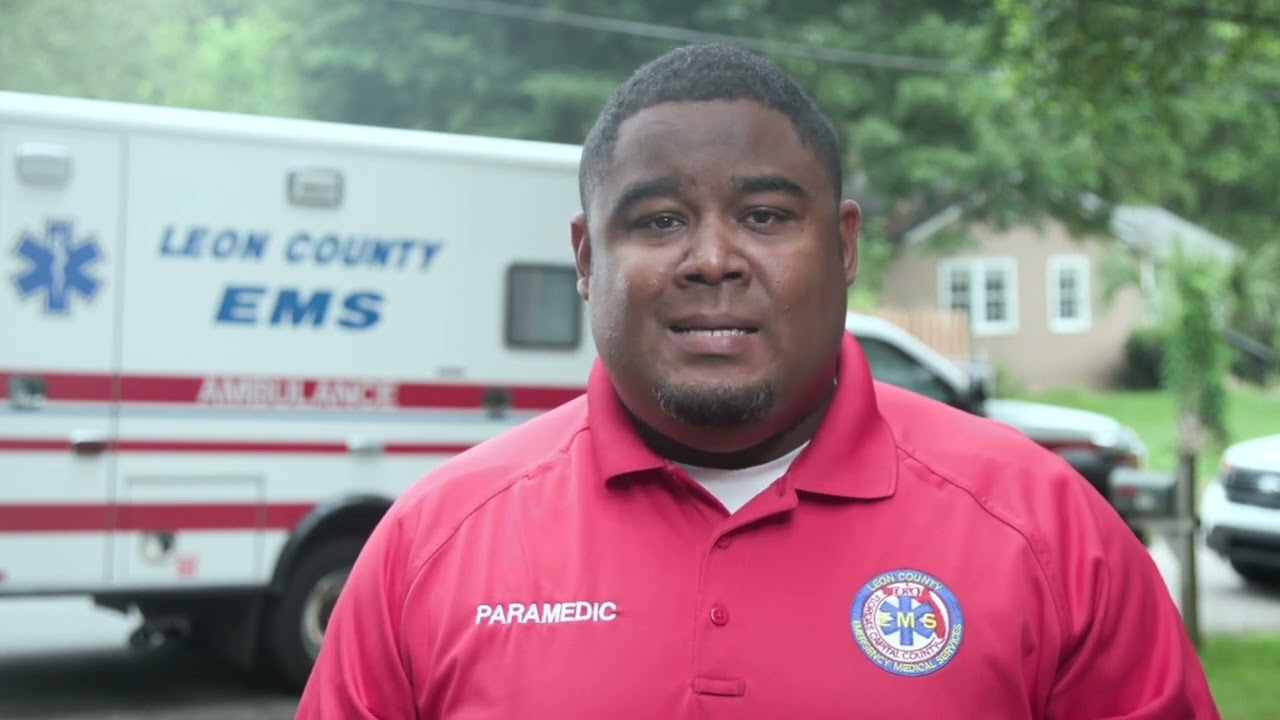Introduction
People living with dementia interact with the world differently and can experience memory loss, mood swings, and confusion. In emergency situations, how first responders and care partners interact with them can help de-escalate an already stressful situation.
These training videos were created for first responders, care partners, and other professionals to show how to use de-escalation and communication strategies with persons living with dementia. They also share tips and resources to reduce recurring incidents.
Viewers can start with the introduction video and then choose a scenario. For each scenario, watch the Setting the Scene video followed by the perspective that is relevant to you, such as the Care Partner’s View. Watching all videos in a scenario is also an option.
This video introduces the REACH approach. REACH stands for:
R – Risk Perception
E – Establish Trust
A – Assess Immediate Needs
C – Calm Environment
H – Healthy Partnerships
Scenario 1 – The Fall
Setting the Scene
Watch a scenario where a person living with dementia believes an intruder is in the home and has experienced a fall in the bathroom. See how emergency response personnel calmly and effectively respond to a call at a private residence to de-escalate the situation.
The Paramedic’s View
See a paramedic’s point of view and the steps they took to
de-escalate the situation and help the person with dementia and their care partner.
Key Takeaways
- Based on provided information, consider if the person has dementia.
- Do not challenge the person with dementia’s reality. Tell them who you are and offer them help.
- Remember a person who lives with dementia may have distorted vision and hearing.
- Put yourself at the person’s eye level and communicate slowly and directly. Use short, simple sentences and use body language and facial expressions to calm the person.
- Calm the environment. Keep noise and distractions to a minimum.
- Limit the use of sirens and radios.
- Cover or remove any reflective surfaces if needed.
- Communicate with a family member or care partner to obtain information that will help establish trust, such as:
- Information on the person’s background, i.e., past job
- Tips to help them stay calm, i.e., mention their grandchildren or pets by name
The Care Partner’s View
See a care partner’s point of view in getting help for their partner with dementia and effectively collaborating with emergency response personnel.
Key Takeaways
- Try to quickly determine the risk of harm.
- Do not challenge the person with dementia’s reality. Remind them who you are and offer them help.
- Put yourself at the person’s eye level and communicate slowly and directly. Use short, simple sentences and use body language and facial expressions to calm the person.
- Consider what the person needs during the crisis situation.
- Call 9-1-1 if medical attention is needed or the situation is unsafe.
- Remember a person who lives with dementia may have distorted vision and hearing.
- Calm the environment. Keep noise and distractions to a minimum, such as:
- Dimming lights or closing the blinds
- Turning off the TV
- Be ready to communicate important information with first responders. Have a document ready that lists a person’s:
- Healthcare providers
- Medical conditions
- Medications
- Allergies
- Insurance
- Emergency contact information
- Copy of advance directives
- Communicate with first responders to provide information that will help calm the person with dementia, such as:
- Sharing an item (ex. photo of pet)
- Mentioning a person by name, such as grandchildren or friend
Scenario 2 – The Wanderer
Setting the Scene
Watch a scenario where a care partner discovers her mother has wandered from the home. See how law enforcement responds timely and effectively to return the person with dementia to safety.
The Care Partner’s View
See a care partner’s point of view in handling a wandering situation. Learn strategies that can help with and prevent potential future events.
Key Takeaways
- Call 9-1-1 as soon as a person is discovered missing.
- Tell dispatchers and first responders that the missing person has dementia.
- Work with first responders by answering questions calmly and to the best of your knowledge.
- Confirm what name the missing person best responds to, i.e., Laura or Mrs. Foster.
- Offer tips to first responders that may help a person feel safe when they are located.
- Have a recent picture available.
- Be prepared with all medical information. Have a document ready that lists a person’s:
- Healthcare providers
- Medical conditions
- Medications
- Allergies
- Insurance
- Emergency contact information
- Copy of advance directives
- Prevention Strategies
- Consider getting a medical ID bracelet.
- Enroll in a safe return program such as Scent Evidence or Project Lifesaver.
The Police Officer’s View – Talking with Care Partners
See a police officer’s point of view in communicating with a care partner and assessing risk to determine a safe return strategy.
Key Takeaways
- Consider approaching as a high-risk situation given that people living with dementia could have memory loss, confusion, and communication, hearing, and vision challenges.
- Remain calm to quickly build trust with a care partner and obtain as much information as possible about the missing person.
- Tell those searching what an individual prefers to be called and information that would help them feel safe, i.e., mention their care partner’s name.
- Share information on local dementia support and safe return programs with families when appropriate.
The Police Officer’s View – On Scene
See a police officer’s point of view in locating the individual who has wandered from home and their successful interaction.
Key Takeaways
- Remember a person who lives with dementia could have memory loss, confusion, and communication, hearing, and vision challenges.
- Persons with dementia may not recognize an unsafe situation.
- Approach individuals from the front and make eye contact, although this may be different from other interactions on scene.
- Use short, simple sentences and use body language and facial expressions to calm the person.
- Calm the environment. Keep noise and distractions to a minimum.
- Limit the use of sirens and radios.
- Move to a quiet, less crowded area.
- Quickly establish trust by:
- Not challenging the person with dementia’s reality.
- Using a person’s preferred name to keep their attention.
- Mentioning a family member or care partner’s name to help them feel safe.
- Determine if medical intervention is needed.
- Reunite the person with their care partner.
- Bring home missing person safely by following the REACH approach.
Credits
These videos were created through a partnership with Aging Advocate and the Dementia Care and Cure Initiative Big Bend Task Force.
Thank you to our FSU College of Medicine Media Production Team, the Tallahassee Police Department, Leon County Emergency Medical Services, and the actors and volunteers who helped make this project possible.
These videos and website are supported by the Health Resources and Services Administration (HRSA) of the U.S. Department of Health and Human Services (HHS) as part of an award totaling $755,000 with 0 percentage financed with nongovernmental sources. The contents are those of the author(s) and do not necessarily represent the official views of, nor an endorsement, by HRSA, HHS, or the U.S. Government.
Resources and Training Materials
Care Partners: Use this printable guide to learn 3 easy steps you can use in an emergency situation.
First Responders: Use this printable guide to learn how to interact with persons living with dementia.
For additional training materials, such as a PowerPoint slide deck, contact the REACH team at [email protected].
Helpful Links
An Area Agency on Aging (AAA) is a public or private non-profit agency, designated by the state to address the needs and concerns of all older persons at the regional and local levels. Contact your region’s Area Agency on Aging for additional resources. In Florida, call 1-800-96-ELDER (35337).
The mission of Family Caregiver Alliance is to improve the quality of the life for family caregivers and the people who receive their care.
Project Lifesaver is the premier search and rescue program operated internationally by public safety agencies, and is strategically designed for “at risk” individuals who are prone to the life threatening behavior of wandering.
The mission of Scent Evidence is to provide effective response systems and services that enable families, communities, and organizations to find missing persons and bring them home safely.
The Alzheimer’s Association is a national organization with state and regional divisions. They provide many free educational resources, training programs, and a 24/7 Helpline (call 800-272-3900). The Association works to end Alzheimer’s and all other dementia by accelerating global research, driving risk reduction and early detection, and maximizing quality care and support.
We Need Your Feedback
We strive to provide high quality resources for older adults, care partners, healthcare and other professionals. After watching the videos, please give us your feedback by completing a brief survey.


